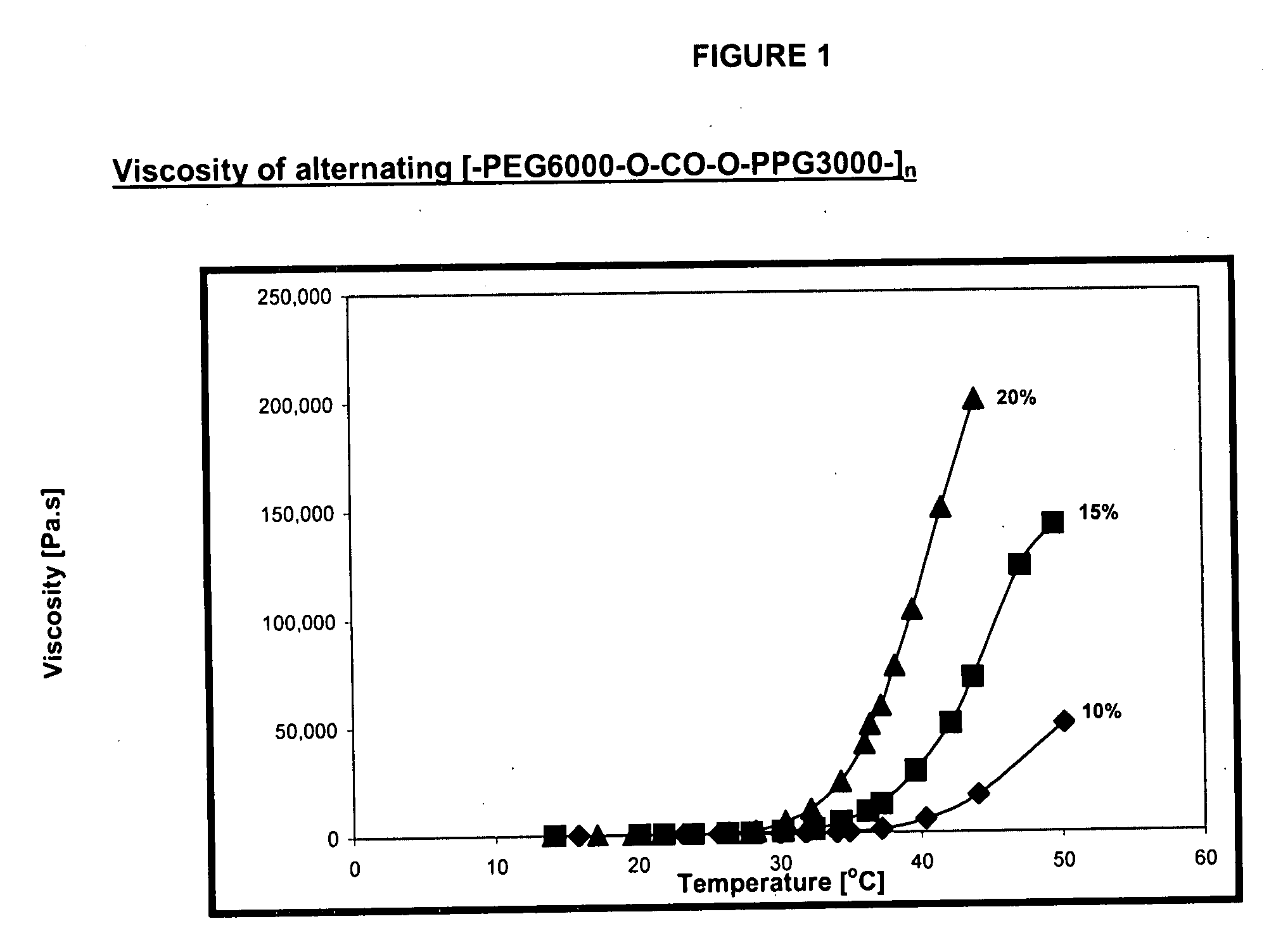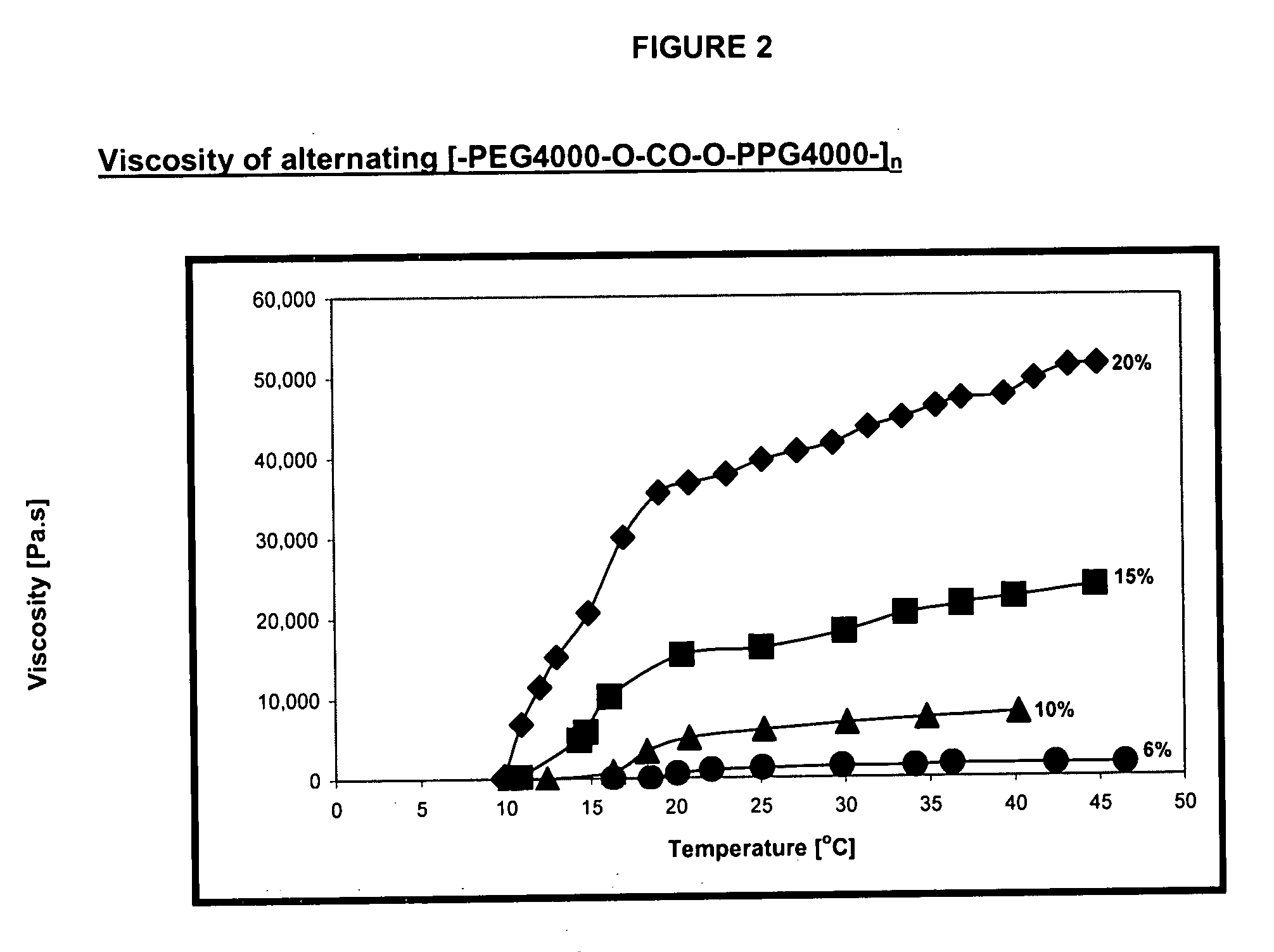Novel reverse thermo-sensitive block copolymers
a technology of reverse thermosensitivity and copolymer, which is applied in the field of new reverse thermosensitivity block copolymer, can solve the problems of toxic n-isopropylacrylamide, non-degradability of poly(n-isopropyl acrylamide), and achieves superior mechanical properties, enhanced initial flowability, and high viscosity
- Summary
- Abstract
- Description
- Claims
- Application Information
AI Technical Summary
Benefits of technology
Problems solved by technology
Method used
Image
Examples
example 1
Synthesis of Alternating [-PEG6000-O—CO—O-PPG3000-]n poly(ether-carbonate)
i) Synthesis of phosgene and Preparation of the chloroformic Solution
[0074] The phosgene was generated by reacting 1,3,5 trioxane (15 g) with carbon tetrachloride (100 g) using aluminum trichloride (30 g) as the catalyst. The phosgene vapors were bubbled in weighed chloroform and the phosgene concentration (w / w) was calculated by weight difference (between 9% and 11%). Due to phosgene's high toxicity, the solution was handled with extreme care and all the work was conducted under a suitable hood.
ii) Synthesis of PEG6000 dichloroformate (ClCO—O-PEG6000-O—COCl)
[0075] 30.3 grams of dried PEG6000 (molecular weight 6,000) were dissolved in 50 ml dried chloroform in a 250 ml flask. 66 gram of chloroformic solution of phosgene 3% w / w (100% molar excess to PEG) were added to the PEG and the mixture was allowed to react at 60° C. for 4 h with magnetic stirring and a condenser in order to avoid solvent and phosgene ...
example 2
Synthesis of Alternating [-PEG4000-O—CO—O-PPG4000-]n poly(ether-carbonate)
i) Synthesis of phosgene and Preparation of the chloroformic Solution
[0077] The synthesis of phosgene and preparation of the chloroformic solution were described in Example 1i).
ii) Synthesis of PEG4000 dichloroformate (ClCO—O-PEG4000-O—COCl)
[0078] The procedure described in example 1ii) was essentially repeated, except that 20.2 grams (0.005 mol) PEG4000 (molecular weight 4,000) and 20 grams of the chloroformic solution of phosgene 7.7% w / w (100% molar excess to PEG), were used. The FT-IR analysis showed the characteristic peak at 1777 cm−1 belonging to the chloroformate group vibration.
iii) Synthesis of Alternating [-PEG4000-O—CO—O-PPG4000-]n poly(ether-carbonate)
[0079] The procedure in example 1iii) was essentially repeated, except that 20.1 grams (0.005 mol) PEG4000 (molecular weight 4,000) and 7.9 grams pyridine were used. A light yellow powder was obtained. The product showed Tg at −74° C. and Tm at...
example 3
Synthesis of Alternating [-PEG3400-O—CO—O-PPG4000-]n poly(ether-carbonate)
i) Synthesis of phosgene and Preparation of the chloroformic Solution
[0080] The synthesis of phosgene and preparation of the chloroformic solution were described in Example 1i).
ii) Synthesis of PEG3400 dichloroformate (ClCO—O-PEG3400-O—COCl)
[0081] The procedure in example 1ii) was essentially repeated, except that 20 grams (0.0059 mol) PEG3400 (molecular weight 3,400) and 19.5 grams of the chloroformic solution of phosgene 5.9% w / w (100% molar excess to PEG), were used. The FT-IR analysis showed the characteristic peak at 1777 cm−1 belonging to the chloroformate group vibration.
iii) Synthesis of Alternating [-PEG3400-O—CO—O-PEG4000-]n poly(ether-carbonate)
[0082] The procedure in example 1iii) was essentially repeated, except that 23.5 grams (0.0059 mol) PPG4000 (molecular weight 4,000) and 7.9 grams pyridine were used. The product was a light yellow powder, which showed a Tg at −73° C. and Tm at 45° C., ...
PUM
| Property | Measurement | Unit |
|---|---|---|
| Length | aaaaa | aaaaa |
| Temperature | aaaaa | aaaaa |
| Viscosity | aaaaa | aaaaa |
Abstract
Description
Claims
Application Information
 Login to View More
Login to View More - R&D
- Intellectual Property
- Life Sciences
- Materials
- Tech Scout
- Unparalleled Data Quality
- Higher Quality Content
- 60% Fewer Hallucinations
Browse by: Latest US Patents, China's latest patents, Technical Efficacy Thesaurus, Application Domain, Technology Topic, Popular Technical Reports.
© 2025 PatSnap. All rights reserved.Legal|Privacy policy|Modern Slavery Act Transparency Statement|Sitemap|About US| Contact US: help@patsnap.com



